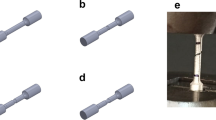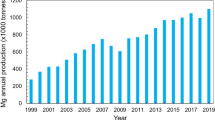Abstract
The study concentrates on the formulation of a reliable constitutive equation for plastic forming of Al–Mg-based alloys above 400 °C and at strain rates above 10−3 s−1. The deformation mechanisms of two coarse-grained Al–Mg alloys, also known as AA5182, with grain sizes 21 and 37 μm were investigated. They exhibited optimum extension at 10−2 s−1 and at T equal to 425 °C and above 475 °C, respectively, with uniform elongation above 300 %. The strain-rate sensitivity and the stress exponent were equal to 0.25 and 4, respectively, suggesting that the deformation is controlled by the solute drag of gliding dislocations whereas dislocation climb occurs also in grains whose orientation renders them hard. Grain boundary sliding may contribute to a small extent in the deformation process. The threshold stress was found to be small and the activation energy lies between 144 and 136 kJ mol−1, i.e., that of Al self-diffusion and Mg diffusion in Al. It is concluded that coarse-grained materials may well fulfill the industrial requirements of forming and within this scope, the use of the low purity coarse-grained Al–Mg-based alloys of the AA5182 type would constitute the next step in the course for further cost reduction.










Similar content being viewed by others
References
Sherby OD, Wadsworth J (1989) Prog Mater Sci 33:169
Langdon TG (2005) Z Metallkd 96:522
Figueiredo RB, Kawasaki M, Xu C, Langdon TG (2008) Mater Sci Eng A 493:104
Valiev RZ, R.K. Islamgaliev RK, Alexandrov IV. Prog Mater Sci 2000;45:103
Taleff EM, Henshall GA, Nieh TG, Leseur DR, Wadsworth J (1998) Metall Mater Trans A 29:1081
Woo SS, Kim YR, Shin DH, Kim WJ (1997) Scripta Mater 37:1351
Taleff EM, Hector LG Jr, Bradley JR, Verma R, Krajewski PE (2009) Acta Mater 57:2812
Soer WA, Chezan AR, De Hosson JThM (2006) Acta Mater 54:3827
Chen Z, Kazantzis AV, De Hosson JThM. Mat.-wiss u Werkstofftech 2008;39:259
Smallman RE, Bishop RJ (1995) Metals and materials: science, processes and applications. Butterworth-Heinemann Ltd, Oxford, p 206
Chang JK, Takata K, Ichitani K, Taleff EM (2010) Metall Mater Trans A 41:1942
Kulas M-A, Green WP, Taleff EM, Krajewski PE, McNelley TR (2005) Metall Mater Trans A 36:1249
Taleff EM, Nevland PJ, Krajewski PE (2001) Metall Mater Trans A 32:1119
Hsiao IC, Huang JC (2002) Metall Mater Trans A 33:1373
Mohamed FA, Langdon TG (1974) Acta Metall 22:779
Sherby OD, Burke PM (1968) Prog Mater Sci 13:323
Köster W (1948) Z Metallkd 39:1
Yavari P, Langdon TG (1982) Acta Metall 30:2181
Sherby OD, Taleff EM (2002) Mater Sci Eng, A 322:89
Du Y, Chang YA, Huang B, Gong W, Jin Z, Xu H, Yuan Z, Liu Y, He Y, Xie F-Y (2003) Mater Sci Eng A 363:140
Simonovic D, Sluiter MH (2009) Phys Review B 79:054304
Kulas M-A, Green WP, Taleff EM, Krajewski PE, McNelley TR (2006) Metall Mater Trans A 37:645
Green WP, Kulas M-A, Niazi A, Oishi K, Taleff EM, Krajewski PE, McNelley TR (2006) Metall Mater Trans A 37:2727
Mohamed FA (1983) J Mater Sci 18(2):582
Chen ZG, Kazantzis AV, De Hosson JThM. (in preparation)
Barrett CR, Ardell AJ, Sherby OD (1964) Trans ASM 20:200
Bae DH, Ghosh AK (2000) Acta Mater 48:1207
King HW (1966) J Mater Sci 1:79. doi:10.1023/A:1018695610937
Weertman, J, Weertman JR, In: Dislocations in Solids, Vol. 3, ed. F.R.N. Nabarro (North-Holland, Amsterdam, 1980), Chapter 8, p.3
Hirth JP, Zbib HM, Lothe J (1998) Modelling Simul. Mater. Sci. Eng. 6:165
Yoshinaga H, Toma K, Abe K, Morozumi S (1971) Philos Mag 23:1387
Eshelby JD (1949) Proc Roy Soc A62:307
McNelley TR, Michel DJ, Salama A (1989) Scripta Metall 23:1657
Acknowledgements
This research was carried out under the project number MC4.05219 in the framework of the Research Program of the Materials innovation institute M2i (www.m2i.nl), the former Netherlands Institute for Metals Research. We gratefully acknowledge the experimental efforts of our Bachelor students J. Bijlsma and H. Kroezen and we thank Prof. Eric M. Taleff of the University of Texas at Austin for his help and advice.
Author information
Authors and Affiliations
Corresponding author
Rights and permissions
About this article
Cite this article
Kazantzis, A.V., Chen, Z.G. & De Hosson, J.T.M. Deformation mechanism of aluminum–magnesium alloys at elevated temperatures. J Mater Sci 48, 7399–7408 (2013). https://doi.org/10.1007/s10853-013-7555-7
Received:
Accepted:
Published:
Issue Date:
DOI: https://doi.org/10.1007/s10853-013-7555-7




